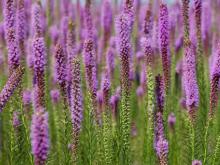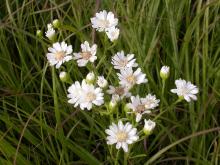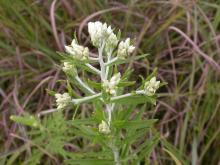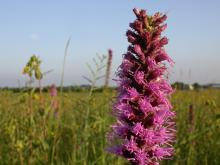Wildflowers, Grasses and Other Nonwoody Plants
Media

Species Types
Scientific Name
Eupatorium perfoliatum
Description
American, or common boneset has small, white flowerheads in flat-topped clusters at the top of the plant. The leaves are hairy, narrowly triangular, and in opposite pairs fused around the stem.
Media

Species Types
Scientific Name
Eupatorium altissimum
Description
A stout perennial that can grow to 6 feet tall, tall thoroughwort is a member of the sunflower family that has dull white flowers and distinctive leaves that are opposite, slender, very short-stalked, and with three quite noticeable veins.
Media

Species Types
Scientific Name
Liatris aspera
Description
Rough blazing star is fairly common and scattered nearly statewide. To distinguish between Missouri’s nine species in the genus Liatris, start by noting details of the flower structure. It’s not hard when you know what to look for.
Media

Species Types
Scientific Name
Liatris pycnostachya
Description
Prairie blazing star has an unbranched stalk with many densely crowded, rose-purple flowerheads. It is a signature wildflower of the tallgrass prairie.
Media

Species Types
Scientific Name
Solidago ptermicoides (formerly Aster ptarmicoides)
Description
With its white, petal-like ray florets and pale disc florets, upland white goldenrod is truly the oddball of the goldenrods: it looks like a white-flowered aster. Indeed, it used to be considered an aster.
Media

Species Types
Scientific Name
Symphyotrichum spp. (formerly Aster spp.)
Description
Missouri has 24 species of New World asters in genus Symphyotrichum. Most have purple or white ray flowers and yellow disk flowers that turn reddish over time. Most bloom in late summer and fall.
Media

Species Types
Scientific Name
Cuscuta spp.
Description
Dodders are easy to identify, even though at first you might not recognize them as plants. These parasitic plants usually look like a hairlike mass of yellow or orange, leafless, wiry, vining stems wrapping around the stems of other plants.
Media

Species Types
Scientific Name
Pseudognaphalium obtusifolium (syn. Gnaphalium obtusifolium)
Description
Sweet everlasting, or old field balsam, catches your eye with its clusters of white, peg-shaped flowerheads and white branches that contrast with the narrow green leaves. It occurs statewide, in a variety of open, sunny habitats.
Media

Species Types
Scientific Name
Liatris spp.
Description
Missouri boasts nine native species of blazing stars, or gayfeathers, in genus Liatris. These showy, upright, unbranching spikes of magenta-pink wildflowers bloom in sunny habitats.
Media

Species Types
Scientific Name
Liatris cylindracea
Description
Cylindrical blazing star is one of several Missouri native species of blazing stars, or gayfeathers. It is widely scattered in the Ozarks and eastern Missouri. Identify it by its bracts, which are pressed against the base of the flowerhead, accentuating its cylindrical look.
See Also
About Wildflowers, Grasses and Other Nonwoody Plants in Missouri
A very simple way of thinking about the green world is to divide the vascular plants into two groups: woody and nonwoody (or herbaceous). But this is an artificial division; many plant families include some species that are woody and some that are not. The diversity of nonwoody vascular plants is staggering! Think of all the ferns, grasses, sedges, lilies, peas, sunflowers, nightshades, milkweeds, mustards, mints, and mallows — weeds and wildflowers — and many more!





















